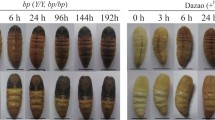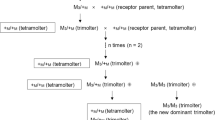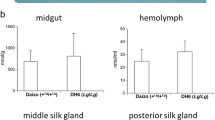Abstract
Dopamine is a precursor for melanin synthesis. Arylalkylamine N-acetyltransferase (AANAT) is involved in the melatonin formation in insects because it could catalyze the transformation from dopamine to dopamine-N-acetyldopamine. In this study, we identified a new AANAT gene in the silkworm (Bombyx mori) and assessed its role in the silkworm. The cDNA of this gene encodes 233 amino acids that shares 57 % amino acid identity with the Bm-iAANAT protein. We thus refer to this gene as Bm-iAANAT2. To investigate the role of Bm-iAANAT2, we constructed a transgenic interference system using a 3xp3 promoter to suppress the expression of Bm-iAANAT2 in the silkworm. We observed that melanin deposition occurs in the head and integument in transgenic lines. To verify the melanism pattern, dopamine content and the enzyme activity of AANAT were determined by high-performance liquid chromatography (HPLC). We found that an increase in dopamine levels affects melanism patterns on the heads of transgenic B. mori. A reduction in the enzyme activity of AANAT leads to changes in dopamine levels. We analyzed the expression of the Bm-iAANAT2 genes by qPCR and found that the expression of Bm-iAANAT2 gene is significantly lower in transgenic lines. Our results lead us to conclude that Bm-iAANAT2 is a new arylalkylamine N-acetyltransferase gene in the silkworm and is involved in the metabolism of the dopamine to avoid the generation of melanin.





Similar content being viewed by others
References
Kato, T., Sawada, H., Yamamoto, T., Mase, K., & Nakagoshi, M. (2006). Pigment pattern formation in the quail mutant of the silkworm, Bombyx mori: parallel increase of pteridine biosynthesis and pigmentation of melanin and ommochromes. Pigment Cell Research, 19(4), 337–345.
Futahashi, R., Sato, J., Meng, Y., Okamoto, S., Daimon, T., Yamamoto, K., … & Fujiwara, H. (2008). Yellow and ebony are the responsible genes for the larval color mutants of the silkworm Bombyx mori. Genetics, 180(4), 1995–2005.
Chen, P., Li, L., Wang, J., Li, H., Li, Y., Lv, Y., & Lu, C. (2013). BmPAH catalyzes the initial melanin biosynthetic step in Bombyx mori. PloS One, 8(8), e71984.
Liu, C., Yamamoto, K., Cheng, T. C., Kadono-Okuda, K., Narukawa, J., Liu, S. P., … & Xia, Q. Y. (2010). Repression of tyrosine hydroxylase is responsible for the sex-linked chocolate mutation of the silkworm, Bombyx mori. Proceedings of the National Academy of Sciences, 107(29), 12980–12985.
Wittkopp, P. J., Carroll, S. B., & Kopp, A. (2003). Evolution in black and white: genetic control of pigment patterns in Drosophila. Trends in Genetics, 19(9), 495–504.
Moussian, B. (2010). Recent advances in understanding mechanisms of insect cuticle differentiation. Insect Biochemistry and Molecular Biology, 40(5), 363–375.
Whitmore, D., Foulkes, N. S., & Sassone-Corsi, P. (2000). Light acts directly on organs and cells in culture to set the vertebrate circadian clock. Nature, 404(6773), 87–91.
Besharse, J. C., & Iuvone, P. M. (1983). Circadian clock in Xenopus eye controlling retinal serotonin N-acetyltransferase. Nature, 305, 133–135.
Ganguly, S., Coon, S. L., & Klein, D. C. (2002). Control of melatonin synthesis in the mammalian pineal gland: the critical role of serotonin acetylation. Cell and Tissue Research, 309(1), 127–137.
Itoh, M. T., Hattori, A., Nomura, T., Sumi, Y., & Suzuki, T. (1995). Melatonin and arylalkylamine N-acetyltransferase activity in the silkworm, Bombyx mori. Molecular and Cellular Endocrinology, 115(1), 59–64.
Tsugehara, T., Iwai, S., Fujiwara, Y., Mita, K., & Takeda, M. (2007). Cloning and characterization of insect arylalkylamine N-acetyltransferase from Bombyx mori. Comparative Biochemistry and Physiology Part B: Biochemistry and Molecular Biology, 147(3), 358–366.
Dai, F. Y., Qiao, L., Tong, X. L., Cao, C., Chen, P., Chen, J., … & Xiang, Z. H. (2010). Mutations of an arylalkylamine-N-acetyltransferase, Bm-iAANAT, are responsible for silkworm melanism mutant. Journal of Biological Chemistry, 285(25), 19553-19560.
Zhan, S., Guo, Q., Li, M., Li, M., Li, J., Miao, X., & Huang, Y. (2010). Disruption of an N-acetyltransferase gene in the silkworm reveals a novel role in pigmentation. Development, 137(23), 4083–4090.
De Angelis, J., Gastel, J., Klein, D. C., & Cole, P. A. (1998). Kinetic analysis of the catalytic mechanism of serotonin N-acetyltransferase (EC 2.3. 1.87). Journal of Biological Chemistry, 273(5), 3045–3050.
Tamura, T., Thibert, C., Royer, C., Kanda, T., Eappen, A., Kamba, M., … & Couble, P. (2000). Germline transformation of the silkworm Bombyx mori L. using a piggyBac transposon-derived vector. Nature Biotechnology, 18(1), 81-84.
Tomita, M., Munetsuna, H., Sato, T., Adachi, T., Hino, R., Hayashi, M., … & Yoshizato, K. (2002). Transgenic silkworms produce recombinant human type III procollagen in cocoons. Nature Biotechnology, 21(1), 52-56.
Thomas, K. B., Zawilska, J., & Iuvone, P. M. (1990). Arylalkylamine (serotonin) N-acetyltransferase assay using high-performance liquid chromatography with fluorescence or electrochemical detection of N-acetyltryptamine. Analytical Biochemistry, 184(2), 228–234.
Dai, H., Jiang, R., Wang, J., Xu, G., Cao, M., Wang, Z., & Fei, J. (2007). Development of a heat shock inducible and inheritable RNAi system in silkworm. Biomolecular Engineering, 24(6), 625–630.
Dai, H., Ma, L., Wang, J., Jiang, R., Wang, Z., & Fei, J. (2008). Knockdown of ecdysis-triggering hormone gene with a binary UAS/GAL4 RNA interference system leads to lethal ecdysis deficiency in silkworm. Acta Biochimica et Biophysica Sinica, 40(9), 790–795.
Thomas, J. L., Da Rocha, M., Besse, A., Mauchamp, B., & Chavancy, G. (2002). 3× P3-EGFP marker facilitates screening for transgenic silkworm Bombyx mori L. from the embryonic stage onwards. Insect Biochemistry and Molecular Biology, 32(3), 247–253.
Gorman, M. J., & Arakane, Y. (2010). Tyrosine hydroxylase is required for cuticle sclerotization and pigmentation in Tribolium castaneum. Insect Biochemistry and Molecular Biology, 40(3), 267–273.
Gorman, M. J., An, C., & Kanost, M. R. (2007). Characterization of tyrosine hydroxylase from Manduca sexta. Insect Biochemistry and Molecular Biology, 37(12), 1327–1337.
Wright, T. R. (1987). The genetics of biogenic amine metabolism, sclerotization, and melanization in Drosophila Melanogaster. Advances in Genetics, 24, 127–222.
Wittkopp, P. J., True, J. R., & Carroll, S. B. (2002). Reciprocal functions of the Drosophila yellow and ebony proteins in the development and evolution of pigment patterns. Development, 129(8), 1849–1858.
True, J. R. (2003). Insect melanism: the molecules matter. Trends in Ecology & Evolution, 18(12), 640–647.
Kohn, M. H., & Wittkopp, P. J. (2007). Annotating ebony on the fly. Molecular Ecology, 16(14), 2831–2833.
Wittkopp, P. J., Stewart, E. E., Arnold, L. L., Neidert, A. H., Haerum, B. K., Thompson, E. M., … & Shefner, L. (2009). Intraspecific polymorphism to interspecific divergence: genetics of pigmentation in Drosophila. Science, 326(5952), 540-544.
Hintermann, E., Jenö, P., & Meyer, U. A. (1995). Isolation and characterization of an arylalkylamine N-acetyltransferase from Drosophila melanogaster. FEBS Letters, 375(1), 148–150.
Amherd, R., Hintermann, E., Walz, D., Affolter, M., & Meyer, U. A. (2000). Purification, cloning, and characterization of a second arylalkylamine N-acetyltransferase from Drosophila melanogaster. DNA and Cell Biology, 19(11), 697–705.
Takeda, S., Vieillemaringe, J., Geffard, M., & Rémy, C. (1986). Immunohistological evidence of dopamine cells in the cephalic nervous system of the silkworm Bombyx mori. Coexistence of dopamine and α endorphin-like substance in neurosecretory cells of the suboesophageal ganglion. Cell and Tissue Research, 243(1), 125–128.
Acknowledgments
This study was supported by the Agricultural Science and Technology Transformation fund (no. 2012GB2F100376). We thank Professor Fangyin Dai of Southwest University (Chongqing, China) for providing the silkworm strains. We are grateful to Professor Chunli Chai of Southwest University for the critical reading of the manuscript. Special thanks to Professor Tianfu Zhao of Southwest University for providing the vectors and assistance with silkworm egg injections.
Author information
Authors and Affiliations
Corresponding author
Rights and permissions
About this article
Cite this article
Long, Y., Li, J., Zhao, T. et al. A New Arylalkylamine N-Acetyltransferase in Silkworm (Bombyx mori) Affects Integument Pigmentation. Appl Biochem Biotechnol 175, 3447–3457 (2015). https://doi.org/10.1007/s12010-015-1516-3
Received:
Accepted:
Published:
Issue Date:
DOI: https://doi.org/10.1007/s12010-015-1516-3




